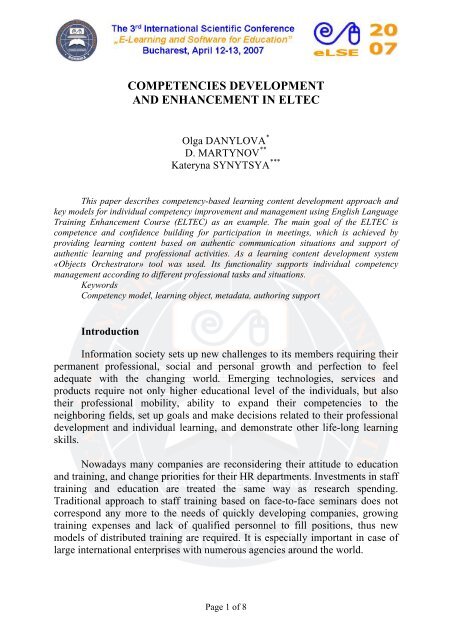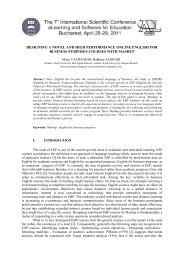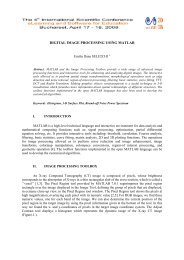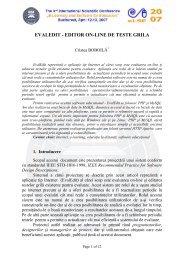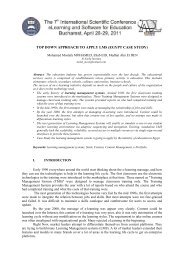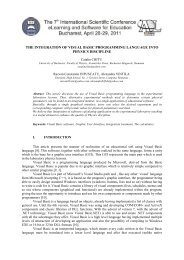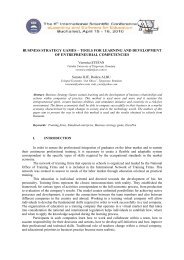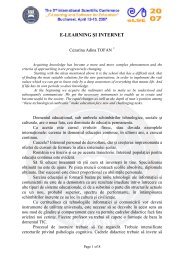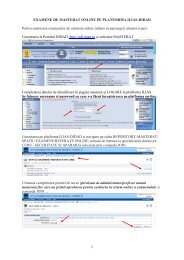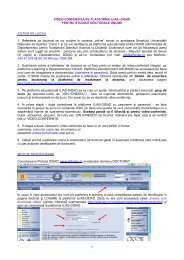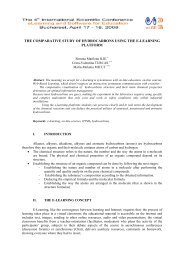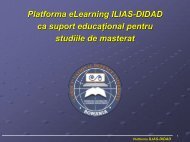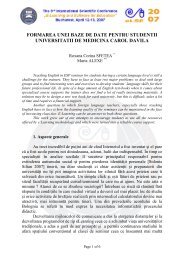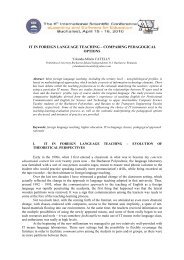Competencies development and enhancement in ELTEC
Competencies development and enhancement in ELTEC
Competencies development and enhancement in ELTEC
Create successful ePaper yourself
Turn your PDF publications into a flip-book with our unique Google optimized e-Paper software.
COMPETENCIES DEVELOPMENT<br />
AND ENHANCEMENT IN <strong>ELTEC</strong><br />
Olga DANYLOVA *<br />
D. MARTYNOV **<br />
Kateryna SYNYTSYA ***<br />
This paper describes competency-based learn<strong>in</strong>g content <strong>development</strong> approach <strong>and</strong><br />
key models for <strong>in</strong>dividual competency improvement <strong>and</strong> management us<strong>in</strong>g English Language<br />
Tra<strong>in</strong><strong>in</strong>g Enhancement Course (<strong>ELTEC</strong>) as an example. The ma<strong>in</strong> goal of the <strong>ELTEC</strong> is<br />
competence <strong>and</strong> confidence build<strong>in</strong>g for participation <strong>in</strong> meet<strong>in</strong>gs, which is achieved by<br />
provid<strong>in</strong>g learn<strong>in</strong>g content based on authentic communication situations <strong>and</strong> support of<br />
authentic learn<strong>in</strong>g <strong>and</strong> professional activities. As a learn<strong>in</strong>g content <strong>development</strong> system<br />
«Objects Orchestrator» tool was used. Its functionality supports <strong>in</strong>dividual competency<br />
management accord<strong>in</strong>g to different professional tasks <strong>and</strong> situations.<br />
Keywords<br />
Competency model, learn<strong>in</strong>g object, metadata, author<strong>in</strong>g support<br />
Introduction<br />
Information society sets up new challenges to its members requir<strong>in</strong>g their<br />
permanent professional, social <strong>and</strong> personal growth <strong>and</strong> perfection to feel<br />
adequate with the chang<strong>in</strong>g world. Emerg<strong>in</strong>g technologies, services <strong>and</strong><br />
products require not only higher educational level of the <strong>in</strong>dividuals, but also<br />
their professional mobility, ability to exp<strong>and</strong> their competencies to the<br />
neighbor<strong>in</strong>g fields, set up goals <strong>and</strong> make decisions related to their professional<br />
<strong>development</strong> <strong>and</strong> <strong>in</strong>dividual learn<strong>in</strong>g, <strong>and</strong> demonstrate other life-long learn<strong>in</strong>g<br />
skills.<br />
Nowadays many companies are reconsider<strong>in</strong>g their attitude to education<br />
<strong>and</strong> tra<strong>in</strong><strong>in</strong>g, <strong>and</strong> change priorities for their HR departments. Investments <strong>in</strong> staff<br />
tra<strong>in</strong><strong>in</strong>g <strong>and</strong> education are treated the same way as research spend<strong>in</strong>g.<br />
Traditional approach to staff tra<strong>in</strong><strong>in</strong>g based on face-to-face sem<strong>in</strong>ars does not<br />
correspond any more to the needs of quickly develop<strong>in</strong>g companies, grow<strong>in</strong>g<br />
tra<strong>in</strong><strong>in</strong>g expenses <strong>and</strong> lack of qualified personnel to fill positions, thus new<br />
models of distributed tra<strong>in</strong><strong>in</strong>g are required. It is especially important <strong>in</strong> case of<br />
large <strong>in</strong>ternational enterprises with numerous agencies around the world.<br />
Page 1 of 8
Distance learn<strong>in</strong>g programs partly address these needs. However, they are<br />
mostly designed as pre-def<strong>in</strong>ed sequences of tra<strong>in</strong><strong>in</strong>g modules, not able to adapt<br />
to <strong>in</strong>dividual knowledge, skills or professional experience of a learner. Whereas<br />
beg<strong>in</strong>ners may benefit from such programs, those that have specific needs due to<br />
change of professional duties or appearance of new products or services they<br />
need to master, require a new type of environment for professional growth<br />
support.<br />
This paper describes an approach to learn<strong>in</strong>g content <strong>development</strong> based<br />
on the professional competency model.<br />
Four-facets competency model<br />
One reason for the <strong>in</strong>creas<strong>in</strong>g importance of competency concept <strong>in</strong><br />
learn<strong>in</strong>g <strong>and</strong> tra<strong>in</strong><strong>in</strong>g is rapid technological <strong>development</strong> <strong>in</strong> society. An<br />
additional reason is that today’s organizations are do<strong>in</strong>g more knowledge <strong>and</strong><br />
service work [6].<br />
We consider competency as a core concept that determ<strong>in</strong>es tra<strong>in</strong><strong>in</strong>g needs.<br />
The follow<strong>in</strong>g basic def<strong>in</strong>ition is used.<br />
Competency - a specific, identifiable, def<strong>in</strong>able, <strong>and</strong> measurable<br />
knowledge, skill, ability <strong>and</strong>/or other deployment-related characteristic (e.g.<br />
attitude, behavior, physical ability) which a human resource may possess <strong>and</strong><br />
which is necessary for, or material to, the performance of an activity with<strong>in</strong> a<br />
specific bus<strong>in</strong>ess context [2].<br />
We suggest the follow<strong>in</strong>g four-facet competency model for efficient<br />
control of competency growth:<br />
1. Structure facet. This facet def<strong>in</strong>es competency structure, its relations to<br />
other competencies <strong>and</strong> thus location with<strong>in</strong> the competency map. We identify<br />
elementary (further non-divisible) competencies <strong>and</strong> complex competencies<br />
which may be described via other (more simple) competencies.<br />
2. Mastery facet. This facet reflects a set of possible mastery levels for a<br />
certa<strong>in</strong> set of competencies, such as beg<strong>in</strong>ner, advanced, professional etc. Thus<br />
it is possible to model quantitative <strong>and</strong> qualitative growth of proficiency <strong>in</strong> some<br />
field <strong>in</strong> case that competency models for beg<strong>in</strong>ner <strong>and</strong> expert are different.<br />
3. KAS facet. Competency may belong to various doma<strong>in</strong>s (categories)<br />
cognitive, affective, <strong>and</strong> psychomotor [1]. Cognitive competency is related to<br />
the mental skills (Knowledge), affective describes growth <strong>in</strong> feel<strong>in</strong>gs or<br />
emotional areas (Attitude), while psychomotor is for manual or physical skills<br />
(Skills). Accord<strong>in</strong>g to KAS (Knowledge, Attitude, Skills) model, after<br />
competency tra<strong>in</strong><strong>in</strong>g (learn<strong>in</strong>g) the learner possesses new skills, knowledge, or<br />
attitudes.<br />
Page 2 of 8
Cognitive doma<strong>in</strong> <strong>in</strong>volves knowledge <strong>and</strong> <strong>development</strong> of <strong>in</strong>tellectual<br />
skills. This <strong>in</strong>cludes the recall or recognition of specific facts, procedural<br />
patterns, <strong>and</strong> concepts that serve <strong>in</strong> the <strong>development</strong> of <strong>in</strong>tellectual abilities <strong>and</strong><br />
skills. There are six major categories – Knowledge, Comprehension,<br />
Application, Analysis, Synthesis, <strong>and</strong> Evaluation. Affective doma<strong>in</strong> <strong>in</strong>cludes the<br />
manner <strong>in</strong> which we deal with th<strong>in</strong>gs emotionally, such as feel<strong>in</strong>gs, values,<br />
appreciation, enthusiasms, motivations, <strong>and</strong> attitudes. The psychomotor doma<strong>in</strong><br />
<strong>in</strong>cludes physical movement, coord<strong>in</strong>ation, <strong>and</strong> use of the motor-skill areas:<br />
Perception, Read<strong>in</strong>ess to act, Guided response, Mechanism, Complex Overt<br />
Response, Adaptation.<br />
4. Last facet reflects competency life cycle. In quickly develop<strong>in</strong>g fields,<br />
such as <strong>in</strong>formation technology (IT), approaches, technologies <strong>and</strong> products are<br />
cont<strong>in</strong>uously updated, which means that competency obta<strong>in</strong>ed several years ago<br />
may be no longer relevant. To reflect ag<strong>in</strong>g of obta<strong>in</strong>ed knowledge <strong>and</strong> skills,<br />
we suggest a measure of competency half-decay, i.e. time period with<strong>in</strong> which<br />
professional competency of the educational body graduate is dim<strong>in</strong>ished <strong>in</strong> half<br />
because of the changes <strong>in</strong> the field. For IT specialists, this period is identified as<br />
4-5 years. Competency life cycle variable reflects ag<strong>in</strong>g of the competency, its<br />
relevance to current state of the art <strong>and</strong> further life potential, which facilitates<br />
rat<strong>in</strong>g of competencies from the same class.<br />
Thus generalized competency model may be represented as:<br />
M C {Structure, Mastery, KAS, Urgency}.<br />
Due to dem<strong>and</strong> of <strong>in</strong>teroperability among learn<strong>in</strong>g systems that deal with<br />
competency <strong>in</strong>formation (human resource systems, learn<strong>in</strong>g content,<br />
competency or skills repositories) model elements description of competencies<br />
is supported by the IMS specification [5]. Such approach allows for expression<br />
of Mastery, KAS <strong>and</strong> Urgency facets.<br />
Object Orchestrator<br />
To support competency-based author<strong>in</strong>g, an OO (Object Orchestrator)<br />
tool [3] was chosen. Started as a simple open-source system for course<br />
<strong>development</strong> support, it was enhanced significantly to become now a core for a<br />
learn<strong>in</strong>g content management framework. Two key functionalities for resource<br />
<strong>development</strong> are supported <strong>in</strong> the OO: construction of the learn<strong>in</strong>g objects<br />
(learn<strong>in</strong>g object builder) <strong>and</strong> their description (metadata editor). As shown <strong>in</strong><br />
Fig.1, metadata editor is a powerful tool which supports st<strong>and</strong>ard metadata<br />
schema for object description but also allows an author to change the schema,<br />
extend<strong>in</strong>g it to reflect specific features necessary for search <strong>and</strong> selection of the<br />
objects.<br />
Page 3 of 8
Figure 1: Metadata editor <strong>in</strong> OO<br />
OO objects, both elementary <strong>and</strong> complex, may be supplied with<br />
metadata created accord<strong>in</strong>g to LOM, DC [4], or some proprietary schema.<br />
However, up to now authors hesitated to describe the objects <strong>and</strong> the use of<br />
metadata was limited to automatic fill<strong>in</strong>g <strong>in</strong> some fields. LOM metadata fields<br />
provide sufficient <strong>in</strong>formation to register an object <strong>in</strong> the repository, however,<br />
they are not specific enough to search <strong>and</strong> evaluate similar objects with<strong>in</strong> a<br />
collection [7]. It is clear that depend<strong>in</strong>g on the object type <strong>and</strong> purpose of its<br />
reuse additional features should be <strong>in</strong>cluded <strong>in</strong>to the description schema.<br />
Due to extensibility of the metadata schema <strong>in</strong> the OO, competency<br />
description scheme based on competency model is completely supported by the<br />
OO metadata editor (as shown <strong>in</strong> Fig. 2).<br />
Page 4 of 8
Figure 2: Competency description scheme <strong>in</strong> OO<br />
Competency-oriented object-based author<strong>in</strong>g ensures consistent<br />
visualization for different <strong>in</strong>formation types, thus facilitat<strong>in</strong>g underst<strong>and</strong><strong>in</strong>g <strong>and</strong><br />
memorization of the presented <strong>in</strong>formation. Thus, a body of a competency-based<br />
course provides a framework <strong>and</strong> guidance for knowledge <strong>and</strong> skills acquisition.<br />
Any supplementary material may be provided as electronic documents or web<br />
references. Objects for the course may be created from the templates or taken<br />
from the collection of already developed objects. Thus, some fragments of the<br />
learn<strong>in</strong>g content from traditional curriculum-based learn<strong>in</strong>g courses may be<br />
reused <strong>in</strong> the competency-based course.<br />
<strong>ELTEC</strong> <strong>development</strong><br />
The choice of language course to prove the validity <strong>and</strong> importance of<br />
competency-based tra<strong>in</strong><strong>in</strong>g was driven by the follow<strong>in</strong>g. Language learn<strong>in</strong>g <strong>in</strong><br />
educational organization, from school to University, is <strong>in</strong>tended to develop<br />
capabilities <strong>and</strong> provide basic knowledge <strong>and</strong> skills to communicate. However,<br />
it is not <strong>in</strong>tended for tra<strong>in</strong><strong>in</strong>g to apply acquired skills <strong>in</strong> specific professional<br />
communication situations. Moreover, lack of practice leads to forgett<strong>in</strong>g<br />
vocabulary necessary for a “real-time” communication, thus professional<br />
communication <strong>in</strong> English becomes an important competency for many fields.<br />
Page 5 of 8
Most learners of English will have to participate <strong>in</strong> meet<strong>in</strong>gs of one type<br />
or another. They may have to meet visitors, organize events, discuss work with<br />
their colleagues, or attend large <strong>in</strong>ternational conferences. In any of these cases,<br />
their ability to respond quickly <strong>and</strong> naturally to new ideas will be critical. They<br />
will feel the pressure to seize the moment to get their ideas across. Competence<br />
<strong>and</strong> confidence to participate fully <strong>in</strong> meet<strong>in</strong>gs will come when they are<br />
equipped with a range of skills <strong>and</strong> language that help them to anticipate <strong>and</strong><br />
h<strong>and</strong>le effectively many of the difficulties they will face.<br />
The ma<strong>in</strong> goal of <strong>ELTEC</strong> is to facilitate competence <strong>and</strong> confidence<br />
build<strong>in</strong>g to enable active participation <strong>in</strong> various k<strong>in</strong>ds of meet<strong>in</strong>gs, by provid<strong>in</strong>g<br />
learn<strong>in</strong>g content based on authentic communication situations <strong>and</strong> authentic<br />
activities support.<br />
The <strong>ELTEC</strong> is a practical course specifically designed to develop<br />
essential communication <strong>and</strong> language skills. <strong>ELTEC</strong> content is arranged around<br />
the key meet<strong>in</strong>g-related communication competencies (Fig. 3) that are supported<br />
by the 6 modules, which deal with the ma<strong>in</strong> stages of meet<strong>in</strong>gs, from preparation<br />
through direct<strong>in</strong>g <strong>and</strong> facilitat<strong>in</strong>g to decision-mak<strong>in</strong>g <strong>and</strong> clos<strong>in</strong>g a meet<strong>in</strong>g.<br />
Meet<strong>in</strong>g<br />
Manager<br />
English IKT Manager<br />
Grammar Vocabulary Speak<strong>in</strong>g Internet M Word Agenda<br />
Figure 3: “Meet<strong>in</strong>g Manager” <strong>ELTEC</strong> competency structure<br />
Each module adds on language capability <strong>and</strong> <strong>in</strong>cludes authentic<br />
examples <strong>and</strong> situations with measurable result at the end. Communication<br />
practice is presented with <strong>in</strong>teractive multimedia components.<br />
Page 6 of 8
The <strong>ELTEC</strong> competence-based structure facilitates its use for on-the-job<br />
<strong>and</strong> just-<strong>in</strong>-time tra<strong>in</strong><strong>in</strong>g <strong>and</strong> enables a learner to focus on competencies<br />
necessary for current situation <strong>and</strong> current task.<br />
Conclusions<br />
In this paper, we propose <strong>in</strong>dividual learn<strong>in</strong>g management approach for<br />
help<strong>in</strong>g <strong>in</strong>dividuals to get new or update current competencies <strong>in</strong> some<br />
professional field. We focus on the competency-based tra<strong>in</strong><strong>in</strong>g <strong>in</strong>dividualization<br />
<strong>and</strong> competency management aspects. Our approach is based on the four-facets<br />
competency model which <strong>in</strong>cludes competency structure facet, mastery facet,<br />
Knowledge- Attitude- Skills facet <strong>and</strong> facet reflect<strong>in</strong>g competency life cycle.<br />
The proposed competency model supports tra<strong>in</strong><strong>in</strong>g process oriented on the<br />
personal characteristics <strong>and</strong> required mastery, cognitive, affective, psychomotor<br />
levels. Competency life cycle variable reflects ag<strong>in</strong>g of the competency <strong>and</strong> may<br />
be used for competency actual status monitor<strong>in</strong>g <strong>and</strong> updat<strong>in</strong>g. OO tool was<br />
used to create competency-based learn<strong>in</strong>g content for the <strong>ELTEC</strong> which is still<br />
under <strong>development</strong>.<br />
Page 7 of 8
References:<br />
[1].Bloom Bengam<strong>in</strong> S, Mesia Bertram B., Krathwohl David R. (1964). Taxonomy of<br />
Educational Objectives (two vols: The Affective Doma<strong>in</strong> & The Cognitive Doma<strong>in</strong>),<br />
New York.<br />
[2].<strong>Competencies</strong> (Measurable Characteristics) Recommendation (2003), Editor:<br />
Chuck Allen, [xml.coverpages.org/HR-XML-<strong>Competencies</strong>-1_0.pdf]<br />
[3].Danylova O., Podgornov A., Synytsya K., <strong>and</strong> Stepanenko Yu. Object-oriented<br />
technology for learn<strong>in</strong>g courses creation «Objects Orchestrator». In Proceed<strong>in</strong>gs of the<br />
International conference «Theory <strong>and</strong> applications <strong>in</strong> software design»<br />
(TAAPSD’2005). (Kiev, Ukra<strong>in</strong>e, 7-9 Dec. 2005) UKMA Press, Kiev, 2005, 106-109.<br />
[4].IEEE Std 1484.12.1-2002. IEEE St<strong>and</strong>ard for Learn<strong>in</strong>g Object Metadata, 2002.<br />
[5].IMS Reusable Def<strong>in</strong>ition of Competency or Educational Objective - Information<br />
Model (2002), [http://www.imsglobal.org/competencies/rdceov1p0/imsrdceo_<strong>in</strong>fov1p0.html]<br />
[6].L<strong>in</strong>dgren R., Competence Systems, Gothenburg Studies <strong>in</strong> Informatics (June<br />
2002), Report 23, ISSN 1400-741X.<br />
[7].Synytsya K. Towards Support of Object-Based Learn<strong>in</strong>g Content Author<strong>in</strong>g,<br />
ICICIS’07, March 15–18, 2007 (Cairo, Egypt), pp. 482-486.<br />
[8].Wiley, D. A. (2000). Learn<strong>in</strong>g object design <strong>and</strong> sequenc<strong>in</strong>g theory. Unpublished<br />
doctoral dissertation, Brigham Young University.<br />
*<br />
Researcher, International Research <strong>and</strong> Tra<strong>in</strong><strong>in</strong>g Centre,Ukra<strong>in</strong>e<br />
** Researcher , International Research <strong>and</strong> Tra<strong>in</strong><strong>in</strong>g Centre,Ukra<strong>in</strong>e<br />
*** PhD , International Research <strong>and</strong> Tra<strong>in</strong><strong>in</strong>g Centre,Ukra<strong>in</strong>e<br />
Page 8 of 8


